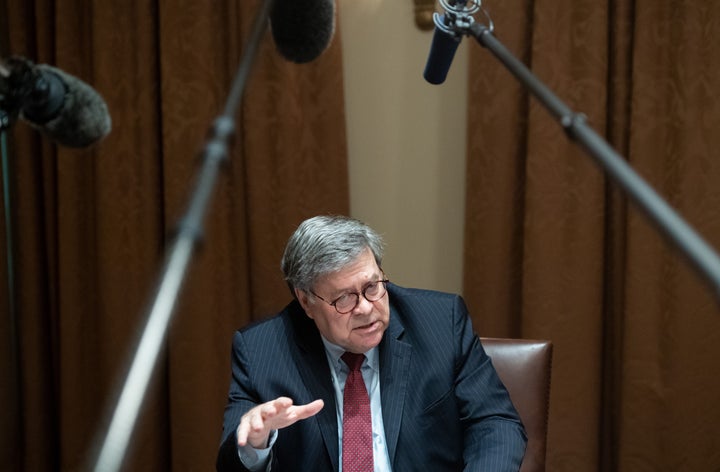WASHINGTON ― President Donald Trump’s firing on Saturday of a top federal prosecutor is once again drawing focus to the role that Attorney General William Barr has played as an enforcer of the president’s personal and political priorities.
After a tense 24-hour standoff that began Friday night, Barr’s varied and contradictory explanations for the departure of U.S. Attorney Geoffrey Berman extended a pattern of misleading statements he’s made during his time atop the Justice Department at a time when the nation’s policing and legal systems are already facing widespread fury and protest.
Barr, who took over as attorney general a few months after Trump fired Jeff Sessions, hasn’t shown much independence from Trump since his confirmation in February 2019. He intervened in the prosecution of Trump associate Roger Stone to advocate for a more lenient sentence, he tried to dismiss charges against former Trump national security adviser Michael Flynn and he’s backed Trump’s whims at nearly every turn.
The highest-profile instance of Barr’s misleading of the public to benefit Trump came when he issued a summary of the special counsel report on Russian interference in the 2016 presidential campaign before Robert Mueller’s report was released last year. Barr’s summary, which Mueller privately complained “did not fully capture the context, nature, and substance” of the report and created “public confusion about critical aspects of the results of our investigation,” steered media coverage of the report for weeks before a fuller, yet still redacted, version was released.
Just before the COVID-19 pandemic slammed the United States, a federal judge appointed by former President George W. Bush issued a remarkable opinion saying that Barr “distorted” the Mueller report. The judge questioned whether Barr intended to create a “one-sided narrative about the Mueller Report — a narrative that is clearly in some respects substantively at odds with the redacted version of the Mueller Report.”
The latest saga unfolded late Friday night, when Berman, the interim U.S. attorney for the Southern District of New York, found out in a press release from the Justice Department that he was “stepping down.” Berman, who was appointed by judges in his district, not Trump ― soon clarified in his own statement that he was not “stepping down” and planned to stay until “a presidentially appointed nominee is confirmed by the Senate.”
Had Berman stepped aside, the Trump administration could have hand-picked a replacement. Barr initially announced that U.S. Attorney for the District of New Jersey Craig Carpenito would fill that spot. But Barr’s attempt to force Berman out, and Berman’s subsequent defiance, forced the administration to follow standard procedure and install Audrey Strauss, Berman’s deputy in the Southern District of New York office, as acting U.S. attorney. Berman praised Strauss and said she would help “safeguard the Southern District’s enduring tradition of integrity and independence.”
There hasn’t been a solid explanation for precisely why the Trump administration wanted to force out Berman. None of the potential reasons for forcing Berman out look particularly great. Even the most benign explanation ― that Trump wanted to nominate his recent golf buddy, Securities and Exchange Commission Chairman Jay Clayton, to the job ― isn’t really standard DOJ operating procedure, especially because Clayton has no prosecutorial experience.
Trump said on Saturday that the decision was “all up to the attorney general” and that he was “not involved.” But legally speaking, Trump had to be involved. Because Berman was appointed by the judges of the Southern District of New York, the Department of Justice’s position was that only Trump could dismiss him.

Trump later told Fox News that he had “to sign a document, or I guess give it the OK” but said he “spent very little time talking about it” with Barr. The White House press secretary said Monday that Trump was involved in Berman’s dismissal only in a “sign-off capacity.”
By then, the misleading public narrative surrounding Berman’s forced departure had once against spoiled trust in Barr. “How can anyone trust Bill Barr’s Justice Department now?” asked the editorial board of The Washington Post.
Barr has also downplayed his role in the June 1 violent attack on protesters as federal law enforcement officers cleared Lafayette Square, next to the White House, ahead of a presidential photo-op at a nearby church. He even claimed that the pepper balls and pepper spray fired at demonstrators were “not a chemical irritant,” even though the manufacturer of pepper balls calls them a “chemical irritant” on its own website.
Senate Minority Leader Chuck Schumer (D-N.Y.) asked the Justice Department’s inspector general and the head of the department’s Office of Professional Responsibility to jointly examine “the removal of the U.S. Attorney Berman and whether he was removed for partisan political purposes, to influence an investigation or prosecution, or to retaliate for his actions in any specific investigation or prosecution.”
In a speech on the Senate floor, Schumer laid out what he called a “sordid, ham-handed plot by President Trump and Attorney General Barr to oust a well-respected U.S. Attorney.”
But House Judiciary Committee Chairman Jerry Nadler (D-NY) said calls for Barr’s impeachment were “a waste of time at this point because we know that we have a corrupt Republican majority in the Senate, which will not consider an impeachment no matter what the evidence and no matter what the facts.”
The Wall Street Journal reported on Monday that Berman refused to sign a letter to New York Mayor Bill de Blasio that contrasted his treatment of protests to his treatment of religious communities. The Justice Department released the letter, which was dated Friday, on Monday afternoon.
The statement DOJ released with the letter was misleading as well. In a press release, the Justice Department claimed de Blasio made the move to Phase 2 of rolling back coronavirus-related restrictions following “action by the Department of Justice Civil Rights Division,” which implied at causal link. In fact, de Blasio announced on Thursday that New York City would be moving to Phase 2 ― before DOJ sent its letter on Friday or made it public on Monday, the day Phase 2 went into effect.
In a separate statement, the Justice Department previously sent a letter to an elected official in Montgomery County alleging that they allowed a protest that featured “hundreds of people packed into a library” to move forward. But that DOJ letter was based on an inaccurate Fox News story. The protest, in fact, took place outdoors in the library parking lot. The Justice Department never publicly corrected its mistake.
